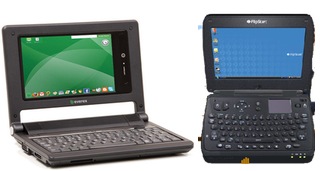
A year ago the then unreleased OLPC XO seemed to have the cheap ultraportable market to itself. However, its altruistic goals limited it to non-retail sales. The idea of $100 (or even the current $200) price for an ultraportable seemed unthinkable for the retail market. Who would buy a cheap small notebook? Then Asus came along with the breakthrough Eee PC. It was not only small and cheap, it also used Linux as its operating system. Hadn’t anyone told Asus that the Linux desktop was a dead idea? Apparently not, and it was a good thing too. The buzz around the Eee seems to have ignited a lot of suits and bean counters to talk to their engineers to create their own low-cost ultraportable. Everex announced their Think CloudBook that will be available from Walmart.com next week for $399. At first glance, it seems like a thicker version of the Eee. But, wait, it has a 30GB hard drive and a DVI-I port at the same price as the Eee PC 4G.
But what about the so-called UMPC (Ultra Mobile PC) concept introduced by Microsoft last year? These small and generally slow devices had prices that seemed inversely related to their size and power: EXPENSIVE. A few have dipped under $1000. But, most seemed to be in the $1200 to $1500 range. This was clearly a lose-lose proposition: Small slow PCs at very high prices. UMPCs must be dead, right? That’s what I thought too until I saw the price drop for the FlipStart. With a price drop down to $699, this Windows Vista capable micro-notebook that has the rare SideNote external LCD looks like a contender now. If other UMPC makers drop their prices nearer the original $500 price announced for UMPCs a year ago, they might gain more interest.
I was all set to order an Asus Eee PC 8G model when they become available. But, I am not in a rush now. I am going to wait and see what else appears in the ultra portable scene. Who knows, some firm might actually revive the old Windows CE (Windows Mobile) Handheld PC genre again (I still use some of my old Handheld PCs for some writing projects).